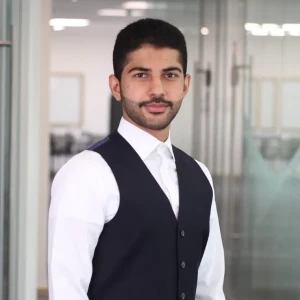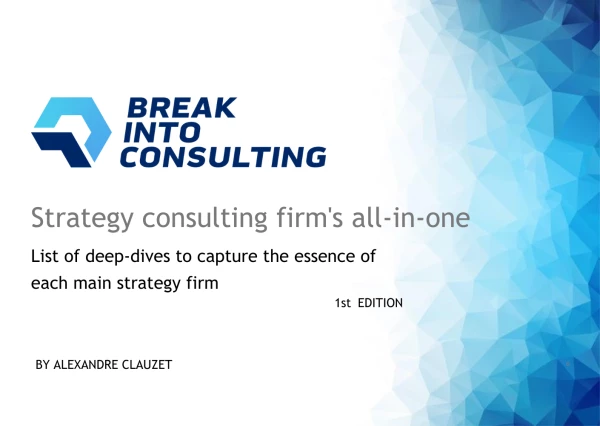Is it best to:
1. Read the graph out loud with the interviewer, then extract conclusions on the fly.
2. Take time to read the graph, write down conclusions, and list them out afterwards.
Is it best to:
1. Read the graph out loud with the interviewer, then extract conclusions on the fly.
2. Take time to read the graph, write down conclusions, and list them out afterwards.


None of the is exactly right.
The right approach is to START WITH THE MAIN QUESTION. See how the graph impacts the main question or influences the recommendation. This is what Bain calls to be ANSWER FIRST. Only then you go through the insights and observations that support that answer.
Reading the graph out loud is not great. If you were with a client would you do something like that? To read the slide back to the client? Definitely not. Of course if you have doubts in interpretation please clarify them, but other than that don't waste communication time telling the interviewers what they already know.

Hi there,
Q: Which approach for graph interpretation is best?
I would recommend something different from what you listed. The approach I would suggest is the following:
1. READ THE GRAPH
2. ANALYZE THE GRAPH AND FIND THE KEY INSIGHTS
3. PROPOSE THE NEXT STEPS
Best,
Francesco


Hi there,
Great question.
Here are the steps:
1. Read the exhibit with the interviewer without actually reading it. This gives you the chance to get a sense of the exhibit before you even take time to digest it. You can also ask clarifying questions at this point.
2. Ask for time. Take 30-60 seconds.
3. Aim to come up with 3 insights or so. Each insight basically consist of you pointing at a piece of data, then explaining what that means, then telling the client what they should do as a consequence of this finding. This last part is actually what makes the whole thing an insight.
4. Once you have a good idea of the 3 insights, get back to the interviewer and present them in a top-down way.
5. For a distinctive answer, reflect at the end on how these 3 insights tell a story about the client's situation and where they are going.
6. Suggest next steps (depending on interview type)
Best,
Cristian

Hi,
from my experience, the best approach may vary depending on the situation and the preferences of the interviewer. However, both of the approaches you mentioned have their advantages and disadvantages.
Approach 1: Reading the graph out loud with the interviewer and extracting conclusions on the fly can show your ability to think on your feet and work well under pressure. This approach may also demonstrate your ability to engage with the interviewer and collaborate effectively. However, there is a risk of making mistakes or missing important details while trying to come up with conclusions on the fly.
Approach 2: Taking time to read the graph, write down conclusions, and list them out afterwards can help ensure that you don't miss any important details and can provide a more thorough and accurate analysis. This approach also shows your ability to organize your thoughts and communicate them clearly. However, this approach may take longer and may not demonstrate your ability to work well under pressure or collaborate effectively.
Ultimately, the best approach may depend on the specific situation and the preferences of the interviewer. If you're unsure, it may be helpful to ask the interviewer which approach they prefer or to try to strike a balance between the two approaches. For example, you could take a few minutes to analyze the graph and write down some initial conclusions, and then review them out loud with the interviewer to get their feedback and refine your analysis.
/Marvin
Hello A!
In my opinion, it's always best to start talking right away, especially during an online interview. You don't have to begin with giving insights; just start describing what you see and include your interviewer in your thought process. This can be very helpful, as if you get something wrong, your interviewer has the chance to step in and guide you.
However, if you come across something that's super complicated or overwhelming, it's perfectly fine to ask for a minute to organize your thoughts.
To sum up, it's not a bad thing to ask for some time, but it's definitely a plus if you can manage to dive right in without hesitation.
Best of luck with everything!

Hi there,
I think this is an interesting question that may be relevant for many people. I would be happy to share my thoughts on it:
If you would like a more detailed discussion on how to best prepare for your upcoming interviews, please don't hesitate to contact me directly.
Best,
Hagen

Great question!
It varies by company.
Generally in interviewee led conversations the interviewer wants to hear the candidates thinking and so for you to explain how you're interpreting the chart as you go through it. That being said, always take a few moments so that you know what you're looking at and don't start reading the chart wrong as you've been too hurried to think it through.
In interviewer-led conversations they will expect you to take time and present your insights rather than tell them what they can already see on the paper.
Good luck!

Hi there,
Please do not extract conclusions on the fly.
If you have a clear obvious conclusion off the bat (because it's an exhibit), then say it!
However, I recommend you:

Hi there,
I would definitely advise you to take some time to understand the graph and find insights to solve the case/question the interviewer asks. This way you are able to give a qualified answer and not fall into the trap of being perceived as clueless.
Cheers
Andreas

Hello,
Never do things on the fly unless you can avoid it - so your approach #2 is better than #1. I would say the best thing is to: take a moment to read and understand the graph, ask interviewers any clarifying questions that might come up, formulate your answer, and then go through it with the interviewer.












